This is a sponsored post in partnership with National Business Furniture. Please note that I’ve included affiliate links for products that help me solve business problems.
You don’t have to work in a factory to be exposed to unsafe working conditions. Surprisingly, an employee can face certain dangers even while sitting in their chair doing work.
A report by Digby Brown Solicitors found that a large percentage of workplace-related injuries are linked to outdated and unsafe workplace furniture.
Technology has changed the way people work. The digital age has created new efficiencies for workers while also creating new issues. Though it certainly has made accomplishing tasks faster and easier, it also brings inherent risks to workers’ health and well-being.
Nowadays while working, people hardly get up from their chairs and move around. They also forget about proper working posture, which exacerbates the issues around a more sedentary work style.
Thus, ergonomics — the study or process of designing workspaces, products, and systems to fit the people that use them — was born.
One of the simplest ways to implement ergonomics in the workplace is through ergonomic furniture.
Jump Ahead to a Specific Section:
What is Ergonomic Furniture?
Ergonomic furniture is specifically designed for efficiency and comfort in the work environment. It is designed in such a way that the user’s body is kept in a safe and upright position to reduce stress on the spine, neck, and hips.
Investing in ergonomic furniture can certainly be pricier than normal furniture but it’s worth it. As with other healthy living best practices, an ounce of prevention is worth a pound of cure. It’s better to proactively create an ergonomic office environment versus waiting until problems arise that may or may not be fixable.
Ergonomic office furniture, especially ergonomic chairs, are especially helpful because most office workers spend about 8 hours seated at their desk, Monday through Friday. Though it’s not completely custom, ergonomic furniture can be adjusted to suit every individual employee’s needs.
But let’s be realistic:
You may not be in a place where it makes sense to upgrade your entire office to ergonomic best practices. With this in mind, we’ll primarily be focusing on how to get results with one particular change: investing in an ergonomic office chair.
Here’s more on why you should get an ergonomic office chair:
Why You Need an Ergonomic Office Chair
I’ve already hinted at the reasons why an ergonomic office chair is worth incorporating into an ergonomic home office (and corporate offices, too).
Let’s dig a little deeper into the specifics:
- Using ergonomic office chairs leads to great health benefits. Among the top reasons why you should get an ergonomic office chair are the health benefits that come with its regular use. Ergonomic chairs can help ease lower back pain, give support to the spine, keep joints in a neutral position, and alleviate neck and shoulder pains. Using ergonomic office products can also reduce the risk of developing musculoskeletal disorders that damage the neck and back.
- Ergonomic chairs provide more comfort. You spend a third of your day in your office chair. It’s hard to sustain a good work ethic for that long if it’s not comfortable. An ergonomic chair can be adjusted to the body’s natural form (and let’s face it, not everyone is built the same way) so that you’re more comfortable while carrying out necessary work tasks.
- Ergonomic office products improve productivity. According to a study from Kelton Global, 92% of respondents said that an inadequate workplace would negatively affect their mental health and productivity.
- Ergonomic furniture increases employee engagement. According to the same Kelton Global study, more than half of American workers believe that having an uncomfortable workspace would cause them displeasure at work.
- Ergonomic office setups provide cost savings over the long-term. Compared to other types of chairs, ergonomic chairs are more expensive from the onset. But they pay off in the long run because they help employees stay healthy. Worker’s compensation is expensive — health is definitely wealth!
What to Look for in an Ergonomic Office Chair
Ok, so you’re considering the upgrade to an ergonomic office chair. But how do you pick between all of the options available on the market?
Start by understanding the characteristics that define a truly ergonomic chair:
- Height-adjustable. Everyone is built differently, so the ideal office chair should be adjustable to the user’s height. As a reference, you should be seated in such a way that your thighs are horizontal to the floor. Check for a lever that can bring the seat higher or lower, as necessary.
- Adjustable backrests. At the same time, you should be able to adjust your backrest so that you can position it in a way that suits whatever task you’re working on. There should be a locking mechanism that holds the backrest in place so that your back isn’t tilting backward. The backrest should also be height-adjustable.
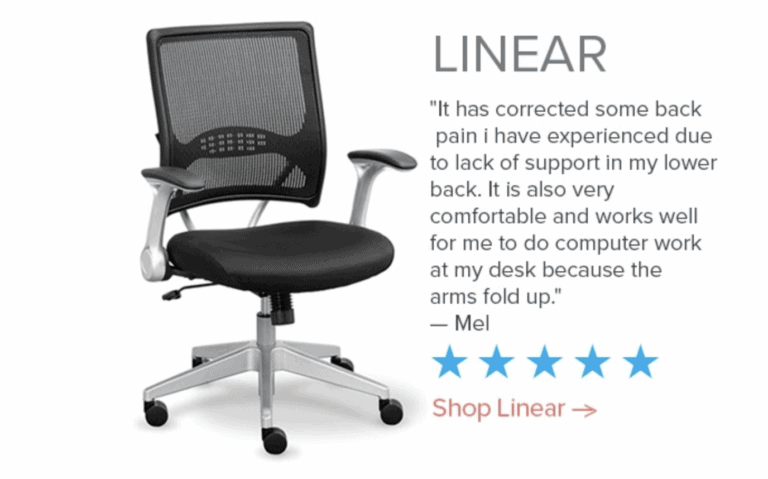
- Breathable material. A seat with a breathable material is more comfortable, especially when you’ll be sitting for long periods of time. Remember to choose padding that is neither too hard (which can be painful to sit on in the long run) nor too soft (which does not offer enough support).
- Lumbar support. Good lumbar support is important to minimize strain or compression on the lumbar discs in your spine. Choose a chair with a backrest that follows the natural curve of the spine. Your lower back should be supported in a way that it is arched all the time so that you don’t slump as the day progresses. Its best to try out this feature before investing in a specific chair.
- Choose a chair with an adjustable armrest so that it allows you to position your arms in a way that makes you comfortable and less likely to slouch, while also reducing strain from your shoulders and neck.
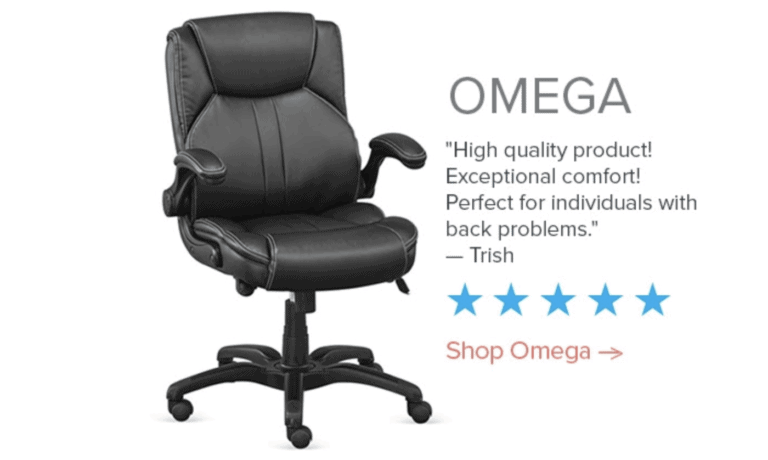
- Easy-to-reach adjustment controls. Make sure that any adjustment controls are easy to reach from a seated position so that you don’t have to struggle to get to them.
- Sufficient depth and width.. The office chair you choose should be wide and deep enough so that you can sit comfortably. Look for a deeper seat if you’re tall, and a shallower one if you’re short. Ideally, you should be able to sit with your back against the backrest, with approximately 2-4 inches between the back of your knees and the seat of the office chair. You should also be able to tilt the seat forward or backward.
- Easy-roll casters.The ability to move around in your chair adds to its usefulness. You should be able to rotate you chair so that you can reach various spots around your workspace easily. Casters (or wheels) make it easier for you to get around, but they should be compatible with your floor type so you don’t have too easy or too hard of a time sliding around. If your chair has casters that aren’t designed for your floor, it’s best to get an area rug. Note that if your chair will be moving over a wood floor or carpet, you’ll want to invest in a chair mat.
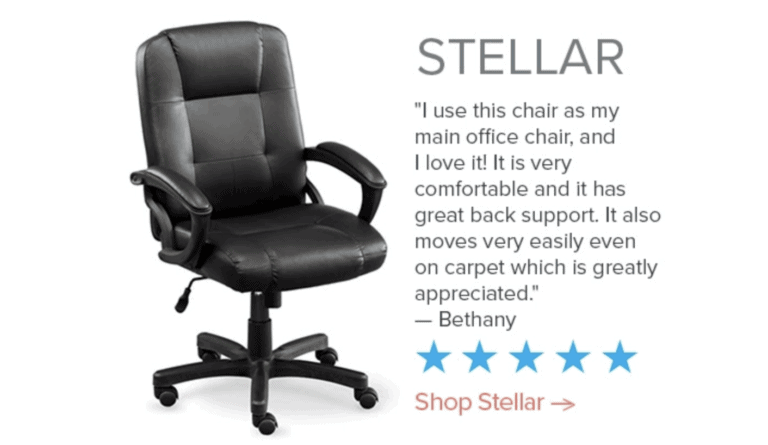
Designing an Ergonomic Home Office
Three stressors can be prevented when you design an ergonomic workspace.
Ironically, these three things are also the common causes of poor ergonomics:
- Force required to do the job
- Awkward/static posture from doing the job
- Repetitiveness of the task
Knowing this, here are some tips to design an ergonomic space:
- Place your monitor at least an arm’s length away from your face, with the top of the screen slightly below eye level (1-2 inches lower if you wear eyeglasses).
- Place your keyboard and mouse as close together as possible, on the same surface and within reach to keep your wrist straight while working.
- Take your office’s lighting and temperature into account, as these are also considered as part of ergonomics. Dim lighting can cause you to feel sleepy and sluggish, while bright lighting can cause you to have trouble concentrating.
With a good handle on how to pick an ergonomic chair and initial thoughts for designing an ergonomic home office space, here are some tips to max out your space with other useful ergonomic office products:
Ergonomic Office Products to Bring it All Together
Investing in an ergonomic office chair is perhaps the single best change you can make to create a healthier and more productive home office workspace.
If you want to maximize the benefits of an ergonomic home office, consider these additional pieces:
An Ergonomic Office Desk
Specifically, standing desks are becoming popular in workplaces to lessen the number of hours in a seated position.
A Bank of France study found that having a standing desk contributed to almost 2.5 times higher muscle activity, further reducing the risk of sustaining a related workplace injury. The study also found that a standing desk can reduce the risk of aches, injuries, and cardiovascular disease by up to 40%.
You can find standing height and adjustable height desks in almost any size and style. Combining standing desks with ergonomic chairs will enable you to move freely through the workday, increasing both mental and physical activity — which all contribute to productivity.
My fiance recently upgraded his home office with this National Business Furniture standing desk and an ergonomic chair of his own.
Check out how it looks at regular height vs standing:
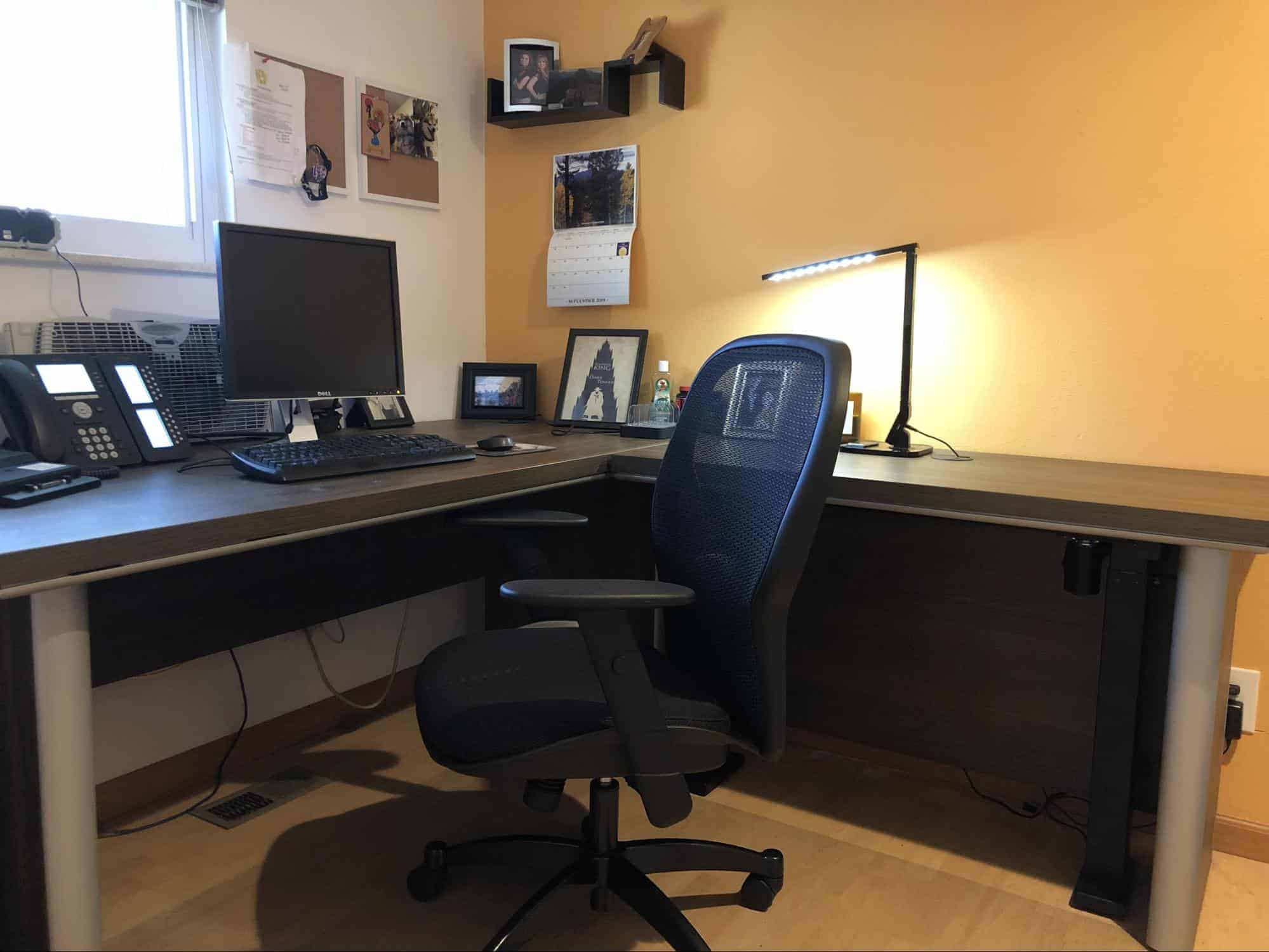
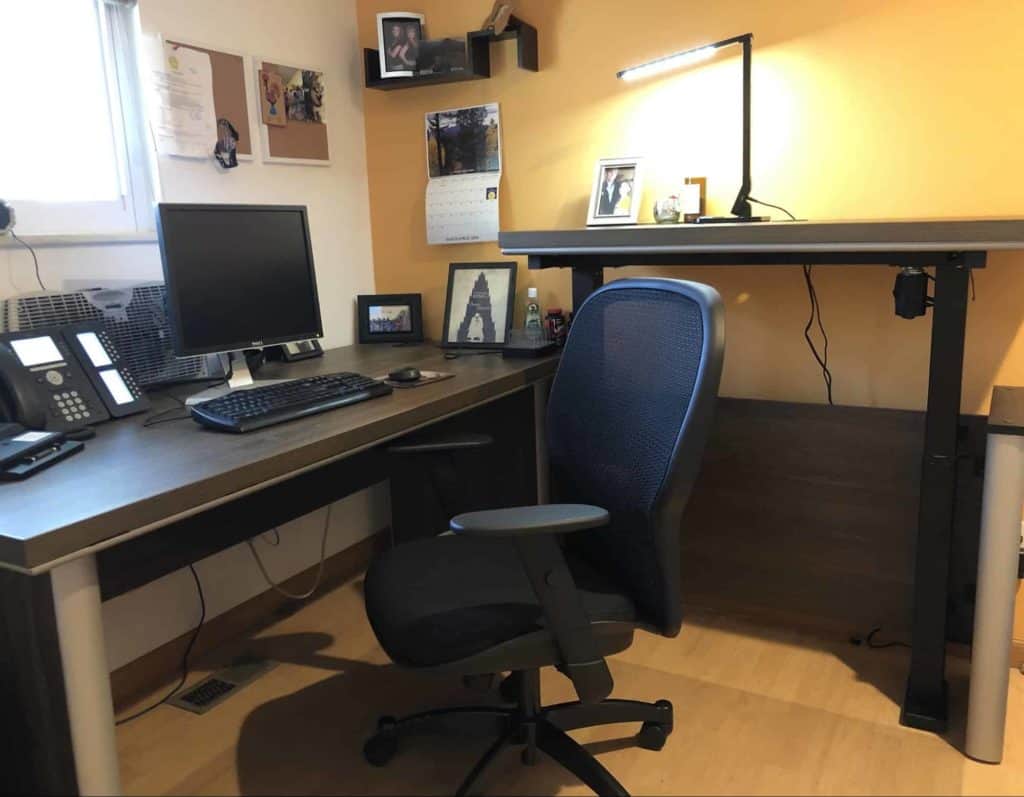
Although I’m not sure I would personally thrive when using a standing desk, my fiance uses it every day — especially when he’s on calls or reading (versus doing intense work). This particular desk is actually motorized: you just hit a button to move it up or down!
Even if you’re not interested in a standing desk, at least make sure your desk allow you to position your arms at the sides and keep your elbows at a 90-degree angle for proper ergonomics.
An Ergonomic Keyboard
An ergonomic keyboard can help increase typing speeds by reducing repetitive reaching and stretching.
On a related note, you’ll also want to consider gel wrist rests. These provide support by alleviating the aches and pains associated with hours of computing by encouraging a neutral wrist posture.
Computer Monitors that Pivot/Tilt
This allows you to focus on your screen for longer periods of time, by reducing eye strains and headaches. Blue blocker glasses can also help if your job involves a lot of screen time.
Additional Tips for Achieving an Ergonomic Home Office Space
Armed with the right ergonomic office furniture and supplies, you’re well on the way to a healthier work situation.
Here are just a few final tips to max out your ergonomic #gains:
- Maintain good posture. What use is having ergonomic furniture if you’re not helping yourself? Maintaining good posture includes sitting at a 100-110 degree angle, not slouching, keeping elbows close to the body and wrists straight, and relaxing the shoulders and back.
- Reduce repetitive movement. Changing tasks or positions reduces potential injury.
- Take breaks every hour. Stand up and move around to give your body a break from sitting.
- Regularly rest your eyes. It’s also important to rest your eyes. The easiest way to do this is to follow the 20-20-20 rule. Look at an object 20 feet away, for 20 seconds, every 20 minutes. Don’t forget to blink often.
- Go hands-free on calls. There are times when you wedge your phone between your shoulder and ear as you try to do two things at once, but doing this frequently can cause muscle tension. With the availability of technology nowadays, why not consider going hands-free? Check out wired/wireless headphones and headsets if you’re frequently on the phone for your job.
Final Thoughts: Everything You Need to Know Before Buying an Ergonomic Office Chair
People spend about a third of their day at work and technology keeps most knowledge workers at their desks. Without the proper workspace setup, this poses occupational hazards that can lead to several health risks.
Luckily, most negative health risks can be mitigated by investing in ergonomic office furniture, which is designed in consideration of the body’s natural shape and movement. But before investing in a new ergonomic office chair or ergonomic office desk, consider the characteristics that make a piece truly “ergonomic”.
Do you have other tips to share for creating an ergonomic home office space? I’d love to hear your thoughts in the comments!

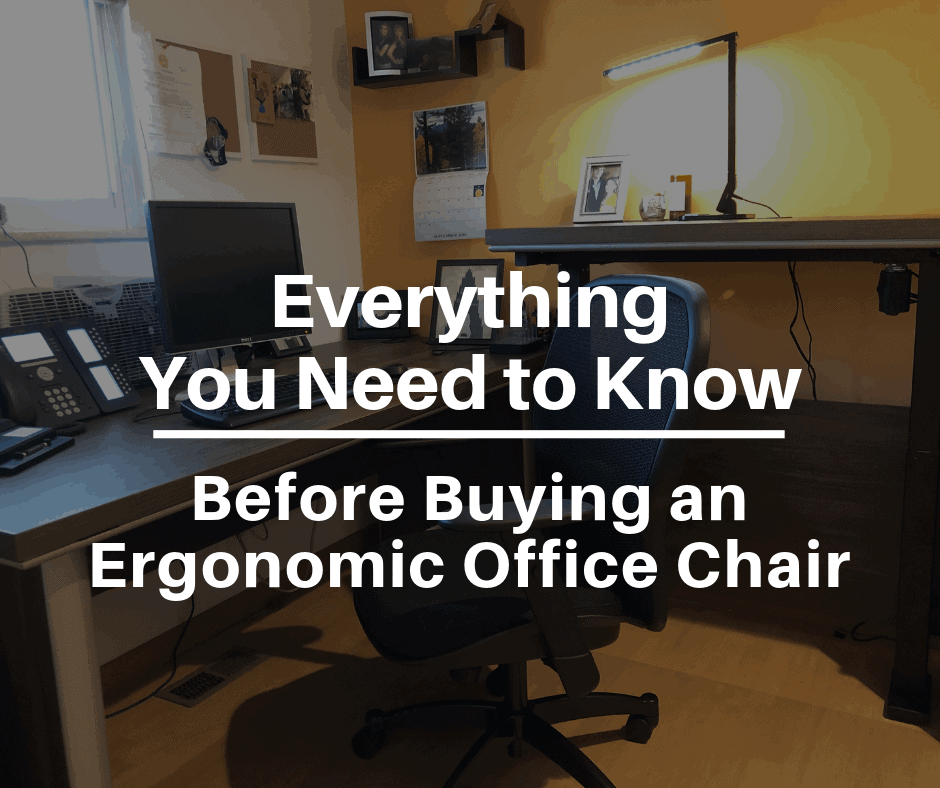










My posture is horrible 99% of the time. But I also recently upgraded to a more ergonomic office chair and am definitely feeling a difference! Thanks for taking the time to share your thoughts here 🙂
Hi Maddy,
It reminded me of a YouTube video that I watched about sitting posters. I realized that we have no idea how to sit on a couch or elsewhere. Often, we’re so focused on the screens that we don’t realize that our furniture isn’t comfortable or per se we’re sitting the wrong way.
I’m glad you took this opportunity and wrote about a physiological factor of working on the computers.
Anyway, it’s a good blog post. I liked it.